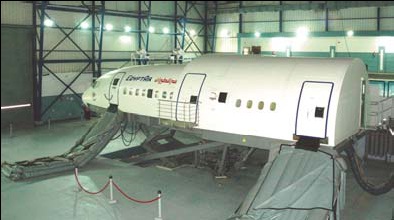Arabian Aerospace Magazine made a nice review on EGYPTAIR TRAINING CENTER "EGYPTAIR looks to be the front runner in Middle East", published in ISSUE 2 August-October 2009. Read On
With Horus the winged god of the sun as its logo, EGYPTAIR has a lot to live up to. The falcon-headed sky diety is evidently a good omen for Egypt’s flag carrier, which has a knack of spotting market opportunities.
For example, while the rest of the world scales back on airliner orders, one region went on a buying bonanza at the recent Paris Air Show. The Middle East was ramping up fleets with an eye on future prosperity. This rapid growth means that finding crew to fly these aircraft will be essential.
However, there simply are not enough properly equipped training facilities in the Middle East and Africa to meet future demand, so EGYPTAIR is seizing the opportunity in a flaccid market to position itself as the frontrunner. Its training division, EGYPTAIR TRAINING CENTER (ETC), was noticeable by its presence at the recent Paris Air Show. ETC was the only training provider to take a booth at the show in a bold bid to supply freshly minted first officers to these new fleets.
So what makes EGYPTAIR confident it is the right training provider for the region? Experience plays a part. Eng M Gamal Said, ETC director of marketing and sales says: “We are the oldest airline in the Middle East and Africa. We were established in 1932 and were the first in both locations. For the last 77 years we have pioneered aviation’s growth here.”
The carrier is a founding member of Arabesk Airline Alliance and the Arab Air Carriers Organization.

Headquartered at Cairo International Airport, EGYPTAIR Holding Company (EHC) is a state-owned enterprise with special legislation permitting the management to operate as if it were a private company. The organisation wholly owns several smaller entities, including ETC, and is self-financing without any financial backing.
Said says: “EGYPTAIR was split into several companies in a strategic move, enabling each facility to make its own decisions. Investing in a training centre was part of that structure.”
The airline division operates scheduled passenger and freight services to more than 70 destinations in the Middle East, Europe, Africa, Asia, and the Americas and is Africa’s second-largest airline. The parent company posted profits of $170 million in the 2007/2008 fiscal year and in 2008, EGYPTAIR traffic increased by 6% to 8.2 million passengers.
This April EHC overhauled its operations at Cairo and created a new terminal. The airline transferred all its operations there and has more than doubled the airport’s capacity.
In addition to EGYPTAIR, EHC shelters several domestic airlines under its umbrella, which have aconstant need for pilots. Said says: “We have invested in training and now have a new building fully equipped with 90 modern classrooms plus four JAR-approved full-flight simulators covering the Airbus A320, the A330 and A340 and the Boeing 777 and B737.” Three of the simulators come from Thales, with the fourth from Flight Safety International, which covers the B737 training.
At present 49% of ETC’s business comes from its parent, but it wants to push that ratio down by 6% over the next few years, so that 55% of its revenues will come from third parties.
The company is hungry for more business. Said continues: “As a business unit EGYPTAIR is a profit centre. We also cater for more airlines in the region including surplus training for Emirates. We intend to expand.”
ETC does not conduct ab initio training; rather it focuses on professional tuition. Said says: “We are already a Type Rated Training Organisation, so pilots come with their ATPLs for transition training.”
Said points out that flight training is not all the TRTO offers and says: “We run courses on cabin service training, emergency training, as well as other aspects that cater for the expansion of all EGYPTAIR’s fleet.” The centre is ISO 9001- approved and offers EASA and GAAC qualifications.
Said says: “All our courses are developed to ICAO standards.” Indeed, IATA and EGYPTAIR have joined forces to bring a whole gamut of professional aviation training to the region. A sample of this summer’s offerings includes international negotiation skills, cargo security, advanced airline sales strategies, aviation law for managers and basic passenger fares and ticketing.
According to Said, ETC is seeing a great deal of business from Europe and expects to see more. He attributes this to lower prices when compared to European training schools, as well as the fact that all the instructors are active pilots for the carrier. He says: “We have experienced personnel on site and our prices are 10-15% below European rates.”
During the 2009 Paris Airshow, EGYPTAIR announced a new venture with US lessor Aviation Capital Group and other Egyptian shareholders to establish a leasing joint venture focusing on the Middle East and Northern Africa. The new joint venture – named Civil Aviation Finance and Operating Leases – will initially focus on narrowbody aircraft. These planes will also need crew.
It was a bold move to exhibit at Paris in the current economic climate, but without intuitive risk there is no growth. Just like its logo, EGYPTAIR’s strategy seems divinely inspired.
Ref: Arabian Aerospace Magazine Issue 2 August-October 2009 Page 85 http://www.arabianaerospace.aero/issue2/ebook/
Highlights